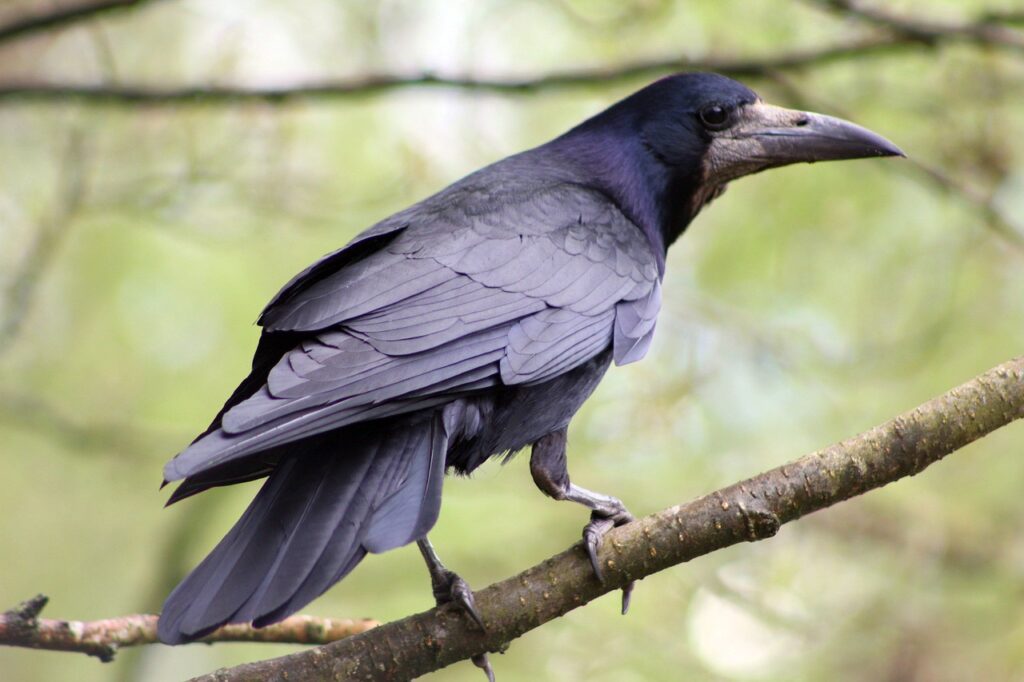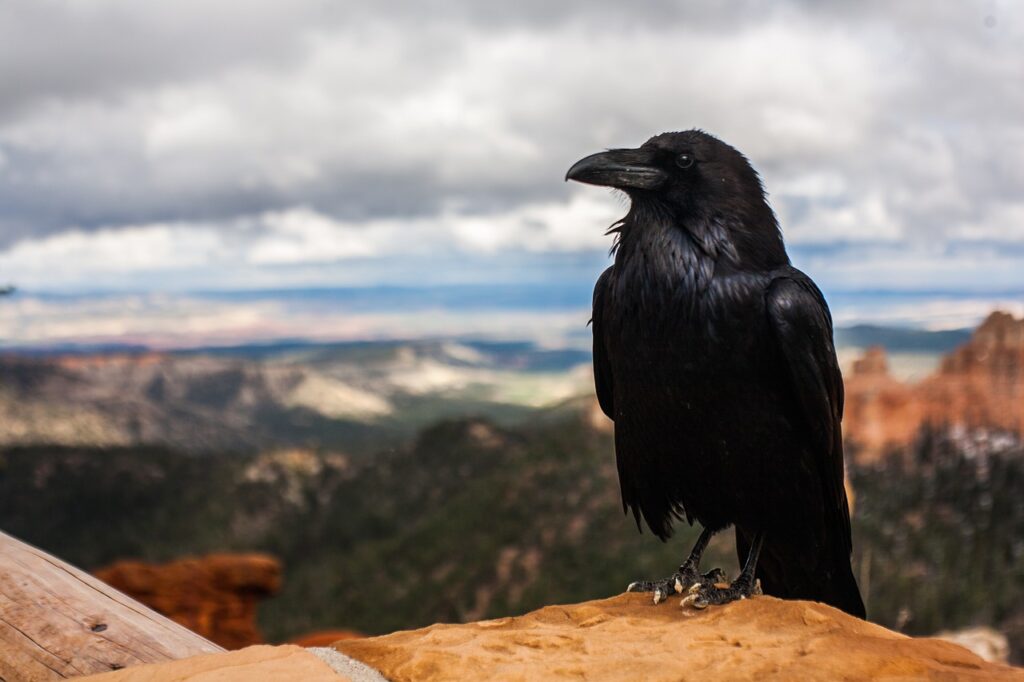DIFFERENCES BETWEEN RAVENS AND ROOKS
Both are members of the Corvidae family, including the jackdaws, jays, crows, magpies, and nutcrackers. As with their Corvidae relatives, ravens and rooks are known for their intelligence, tractability, and adaptability to living in proximity to areas of human influence. Rooks and ravens have been observed to demonstrate self-awareness when subjected to mirror tests. In addition, both can be easily taught the basics of tool-using, puzzle-solving, and rudimentary communication. This level of intelligence can be attributed to the size of their brains, which is large relative to their bodies. This brain-to-body ratio is just about equal to that of the cetaceans ( whales, dolphins ), the great apes ( gorillas, chimpanzees ), and humans.
But what makes a raven different from a rook? Let us look at five categories to better understand how these two birds are: size, appearance, habitat, diet, intelligence, behavior, and evolution.
1. SIZE
The raven and the rook and the crow and the other Corvids are the largest passerine birds. Ravens are larger than crows. A fully mature raven can weigh somewhere between 2 to 5 pounds; it is about 26 inches long and has a wingspan of about 50 inches.
By comparison, the rook is smaller than a raven. A mature rook is about 18 inches long and has a wingspan of approximately 35 inches. It can reach a maximum weight of around 2 pounds.
2. APPEARANCE
The rook is visually distinguishable for its black plumes, which often display a bluish or purple sheen when hit by bright light. Younger rooks have a greenish gloss and are much more similar to the common crow in appearance. The rook’s head, neck, and shoulders appear large and prominent due to a mane of heavy feathers. The region in front of the eyes to the bill appears bare and white. This makes the bill appear larger than it is. This is often the visual cue used by birdwatchers to easily identify rooks from ravens and crows. When the rook flies, its wings appear to be larger than longer than those of a crow.

Ravens are larger than crows. They have larger beaks, dense feathers, and wider tails. These wide trails are what sets them apart from crows when they are observed in flight. Their wide wings enable them to soar at higher altitudes. Their heavier bodies do not affect their flight, as they are as agile as the rest of the Corvids. Ravens from regions with colder climates tend to have bulkier bodies and smaller beaks. On the flipside, ravens from warmer regions have smaller bodies and proportionately larger beaks. Another distinguishing quality of ravens is that they have a deeper and more hollow vocalization than crows.

3. HABITAT
Ravens are hardy birds that can live and survive in nearly all types of ecosystems; Unlike the other Corvids, they can be found nearly all over the world. They can be found in the cold and sub-arctic regions in Europe, Asia, and North America. They have been observed soaring at high altitudes across the Himalayas. They equally thrive in the arid and desert regions in North Africa. They are also adapted to live in tropical regions and islands across the Pacific.
Although they can survive in nearly any terrain and climate conditions, they will always look for sheltered woodland areas surrounded by open spaces such as coastlines and forest clearings. In the coastlines, they will frequent elevated cliffs where they can build their nests in relative safety. They have adapted well by living among dense human settlements such as towns and cities, as these areas mean an abundant food source. Another reason why ravens tend to prefer living in proximity to coastlines is that the climate and weather conditions in these areas are more stable. Ravens do not adapt well to areas where terrain and weather conditions shift constantly and rapidly.
Rooks have a much more limited geographical distribution compared to ravens. They are concentrated in an area ranging from Central Europe to the British Isles. They do not share the same habitat as ravens. Where ravens prefer contoured terrain where wooded areas and open coastal areas meet, rooks prefer lowland pastures and farmlands. Like ravens, they are comfortable living alongside human settlements. But they prefer small rural towns over industrial zones and cities. Rookeries are usually common in areas where there are tall trees. Rooks are also found in some areas in Asia. In New Zealand and Oceania, they are also found. But they are not native to these areas. Today, the rooks in Oceania are the descendants of the birds introduced in the late 1800s.
4. DIET
Rooks are omnivorous, with their dietary behavior ranging from that of being predators to being scavengers. They equally subsist on plant-based food and animals. They feed primarily on seeds and fruits. Since they are also found in agricultural areas, they are also known to feed on potatoes, other root crops, and grain. They also feed on insects, spiders, snails, slugs, small birds, eggs, worms, and small mice. They also feed on carrion. Rooks have also become particularly adept in picking food scraps and leftovers from trash bins and plastic garbage packs. They often favor tourist trails and picnic areas because of the steady supply of food.
Ravens are also opportunistic when it comes to diet. They will adapt depending on the scarcity, climate, and location. In areas where vegetation is barren, they will be predators and scavengers. They will hunt voles and miles. But they will also strip carcasses of moose and caribou. They are intelligent enough to steal bits and pieces of meat from half-eaten prey, avoiding being preyed upon by the predators themselves. There is much more vegetation in areas with much more vegetation, feed on seeds and berries, and fruits.
They will actively hunt for invertebrates, small reptiles, frogs, and bird younglings from other birds’ nests and coastal areas. They are notorious for raiding nests. They have also been observed to pick undigested material from the waste products of animals. Ravens are pretty intelligent that they are capable of storing extra food in caches. They are so adept at keeping food that they can avoid detection from their fellow ravens.
5. INTELLIGENCE
All Corvids are known for their intelligence. The rooks are unique in that they can process puzzles. They fully understand the idea of being able to solve puzzles to earn rewards such as food. They are so adept that they can quickly master puzzles that involve avoiding triggering traps and navigating through a complex pattern to access a reward.
There are cases of rooks trained in captivity to use tools to solve problems. They are also capable of learning. In one case, they were trained to push a pebble into a mechanism to activate a lever that will release food.
In the next stage of the experiment, the pebbles were taken away to see how the ravens would react. True to form, they were able to immediately make the connection between the pebble and the food. They flew away to fetch pebbles to activate the food-dispensing mechanism. Rooks are also capable of cooperating to attain a common goal.
Aside from the ability to solve puzzles, ravens are believed to be the only animals, aside from humans, ants, and bees, to understand the idea of time as a passing concept. Animals are generally only aware of the present. But ravens have demonstrated the capacity to think in terms of the past and the future. For example, when a raven stumbles upon a food supply, it can return to the roost and convey its prior discovery to its fellow ravens. A significant consequence of this ability is that ravens have a good memory. They will remember what was communicated to them and act on it even if several hours or days have passed.
6. BEHAVIOR
Although ravens form flocks similar to other birds, they usually spend their adult lives traveling as mating pairs. And they have such long lifespans. In captivity, they can live for up to 25 years. In the wild, they can survive even in the presence of their natural enemies and predators because they can cooperate with and among each other. Ravens will tend to work together to aggressively defend their nests and territories from other birds such as eagles.
Rooks also pair and mate for life while continuing to live in the safety of the flock. They have also been observed sharing the same roosting spots with the Corvid cousins, the jackdaws; it seems that both jackdaws and rooks have a genuine and intelligent understanding of the safety that comes with numbers.
7. EVOLUTION
Ravens are traditionally known by the binomial name Corvus corax.
The scientific name for the rook is Corvus frugilegus. This binomial name translates into “fruit-gathering raven.” There are two extant varieties. The western rook ( Corvus frugilegus frugilegus ) is endemic to western Europe, Russia, and China’s northern regions. The eastern rook ( Corvus frugilegus pastinator ) is found in Siberia, Mongolia, and across Asia.
QUESTIONS AND ANSWERS
ARE ROOKS GOOD PETS?
Yes. And this typical with most Corvids. They are intelligent birds that can be trained to do different things. As long as food and rewards are part of the motivation, rooks are among the easiest birds to train.
ARE RAVENS EASY TO TRAIN?
Yes. They are the most tractable of the Corvids. They are capable of understanding the rudimentary aspects of communication. In addition, ravens also have such good memories. At some point, they can be commanded to do some of the tasks they were trained to do, even without the need to motivate them with food as a reward.
CAN ROOKS UNDERSTAND HUMAN LANGUAGE?
It is possible, given that they have the necessary brain-to-body ratio standard with other intelligent animals.
CAN RAVENS UNDERSTAND HUMAN LANGUAGE?
While they may not necessarily understand syntax, grammar, and context, they can sense cues and verbal signals in vocalizations.
